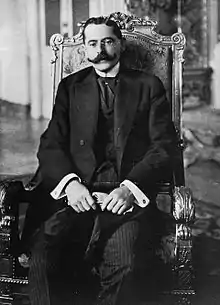Francisco S. Carvajal | |
|---|---|
 Carvajal in 1914 | |
| 40th President of Mexico | |
| In office 15 July – 13 August 1914 | |
| Vice President | Vacant[lower-alpha 1] |
| Preceded by | Victoriano Huerta |
| Succeeded by | Eulalio Gutiérrez (recognized by the Convention of Aguascalientes) Venustiano Carranza (as First Chief of the Constitutional Army and constitutional President of Mexico)[lower-alpha 2] |
| Personal details | |
| Born | Francisco Sebastián Carvajal y Gual 9 December 1870 Campeche, Campeche, Mexico |
| Died | 30 September 1932 (aged 61) Mexico City, Mexico |
| Resting place | Panteón Francés |
Francisco Sebastián Carvajal y Gual, sometimes spelled Carbajal[1] (9 December 1870 – 30 September 1932) was a Mexican lawyer and politician who served briefly as president in 1914, during the Mexican Revolution.[2] In his role as foreign minister, he succeeded Victoriano Huerta as president upon the latter's resignation.
Biography
Born in 1870 in Campeche, Carvajal studied jurisprudence. He occupied important positions in the administration of President Porfirio Díaz. On May 3, 1911, Díaz named him as his representative at the peace conference with constitutionalist rebel Francisco I. Madero. In 1913, after Victoriano Huerta had seized power from Madero, Huerta named him president of the Supreme Court. Later (10 July 1914), Huerta named him to the cabinet as foreign minister. When Huerta resigned on 15 July, Carvajal was legally next-in-line to the presidency.
During his month-long presidential term, he oversaw the transfer of power to Venustiano Carranza and his Constitutionalist Army under the terms of the Teoloyucan Treaties. Carvajal left office on August 13, 1914; Carranza gained de facto control of the executive the following year, despite not being formally elected to the Presidency until 1917.
Carvajal left for the United States. In New Orleans, he met and married Louise Martin. They had one child, Francisco Carvajal, on October 19, 1918. He returned to Mexico City in 1922 to take up his legal profession again and died there on September 20, 1932.
See also
Notes
- ↑ After the ousting of President Francisco Madero and Vice President José María Pino Suárez, Presidents Pedro Lascuráin and Victoriano Huerta, technically being interim presidents, lacked vice presidents. Carvajal was another interim president, and also lacked a vice president. Mexico did not have a constitutional president after Carvajal until Venustiano Carranza created the Constitution of 1917, and won the election that year. The 1917 Constitution lacked a vice presidential position, and Carranza ran with no running mate. Pino Suárez was thus Mexico's final vice president.
- ↑ After the ousting of President Victoriano Huerta, and Carvajal's brief interim presidency, Venustiano Carranza formed the Constitutionalist Army and proclaimed himself leader of Mexico, while the forces of Pancho Villa and Emiliano Zapata held the Convention of Aguascalientes, which appointmented three men to serve as President in 1915. Carvajal's immediate successor was Eulalio Gutiérrez as he was selected by the Convention. Carranza was the next constitutional president, although by 1917 when Carranza officially took office, the Constitution of 1917 had replaced the previous one Carvajal had served under.
References
- ↑ Knight, Alan. The Mexican Revolution, v. 2, 170-71. Cambridge: Cambridge University Press 1986.
- ↑ "FRANCISCO S. CARVAJAL" (in Spanish). Presidency de la Republica de Mexico. Archived from the original on May 30, 2019. Retrieved May 29, 2019.
- (in Spanish) "Carvajal, Francisco", Enciclopedia de México, vol. 6. Mexico City, 1996, ISBN 1-56409-016-7.
- (in Spanish) García Puron, Manuel, México y sus gobernantes, v. 2. Mexico City: Joaquín Porrúa, 1984.
- (in Spanish) Orozco Linares, Fernando, Gobernantes de México. Mexico City: Panorama Editorial, 1985, ISBN 968-38-0260-5.
External links
- (in Spanish) Short biography
